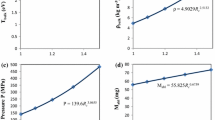Abstract
An electrothermal gun is the device that produces high-temperature and high-velocity plasma vapor using high current pulsed power and has a potential to be an efficient method for producing a variety of nanomaterials. Pulsed plasma discharge from the electrothermal gun into the open air has been investigated numerically, and the time-dependent inviscid gas dynamics equations are solved for the two-dimensional computational domain including electrothermal gun and the open-air space using flux-corrected transport (FCT) scheme. The modeling of the Joule heating and the mass ablation from the bore wall are incorporated in the computation. The computational results yield the details of the plasma discharge behavior inside and outside the capillary bore including choked condition at the bore exit and complex shock structure of external plasma discharge. The flow structure of freely expanding plasma discharge in the open air is essentially the highly underexpanded supersonic jet featuring Mach disk, barrel shock, contact surface, and spherical blast wave. Compared to the experiments, the numerical simulation agrees well with the experimental data such as the capillary mass ablation and shock structure of the plasma jet.











Similar content being viewed by others
References
K.J. White, G.L. Katulka, T. Khong, and K. Nekula, “Plasma Characterization for Electrothermal-Chemical (ETC) Gun Applications,” ARL-TR-1491, U. S. Army Research Laboratory, Aberdeen Proving Ground, 1997
M.J. Nusca, K.J. White, A.W. Williams, A.M. Landsberg, T.R. Young, and C.A. Lind, “Computational and Experimental Investigations of Open-Air Plasma Discharges,” AIAA Paper 99-0865, 1999
J.M. Kohel, L.K. Su, N.T. Clemens, and P.L. Varghese, 1997. Emission Spectroscopic Measurements and Analysis of a Pulsed Plasma Jet,” IEEE Trans. Magn., 35(1), 201–206.
J.U. Kim, N.T. Clemens, and P. L. Varghese, “Experimental Study of an Underexpanded Pulsed Plasma Jet,” AIAA Paper 99-0452, 1999
J.D. Powell and A.E. Zielinski, “Theory and Experiment for an Ablating-Capillary Discharge and Applications to Electrothermal-Chemical Guns,” BRL-TR-3355, U.S. Army Ballistic Research Laboratory, Aberdeen Proving Ground, 1992
J.D. Powell and A.E. Zielinski, 1993, Capillary Discharge in the Electrothermal Gun, IEEE Trans. Magn., 29(1), 591–596
L.L. Raja, P.L. Varghese, and D.E. Wilson, 1997, Modeling of the Electrogun Metal Vapor Plasma Discharge, J. Thermophys. Heat Transfer, 11(3), 353–360
M.F. Zaghloul, M.A. Bourham, and J.M. Doster, 2001, Semi-Analytical Modelling and Simulation of the Evolution and Flow of Ohmically-Heated Non-Ideal Plasmas in Electrothermal Guns. J. Phys. D: Appl. Phys., 34, 772–786
K. Kim, 2003, Time-Dependent One-Dimensional Modeling of Pulsed Plasma Discharge in a Capillary Plasma Device,” IEEE Trans. Plasma Sci., 31(4), 729–735.
E.M. Schmidt, D.D. Shear, 1975, Optical Measurements of Muzzle Blast, AIAA J., 13(8), 1086–1091.
B.E. Djakov, V. Hermoch, 2003, “Plasma Formation at the Electrodes of Pulsed Arcs,” Vacuum, 69, 129–132.
R.W. Liebermann and R.J. Zollweg, 1987, “Electrical Conductivity of Nonideal Plasmas,” J. Appl. Phys., 62(9), 3621–3627
J. Batteh, J. Powell, D. Sink, and L. Thornhill, 1995, “A Methodology for Computing Thermodynamic and Transport Properties of Plasma Mixtures in ETC Injectors,” IEEE Trans. Magn., 31(1), 388–393.
J.P. Boris, A.M. Landsberg, E.S. Oran, and J.H. Gardner, “LCPFCT—Flux-Corrected Transport Algorithm for Solving Generalized Continuity Equations,” Naval Research Laboratory Report No. 6410-93-7192, 1993
J.P. Boris, “Flux-Corrected Transport Modules for Generalized Continuity Equations,” NRL Memorandum Report 3237, Naval Research Laboratory, Washington, D.C., 1976
J. Iwamoto, 1990.“Impingement of Under-Expanded Jets on a Flat Plate. J. Fluid Eng. Trans. ASME, 112, 179–184
Acknowledgments
The author greatly acknowledges Professors N. T. Clemens and P. L. Varghese of The University of Texas at Austin for providing their experimental data and valuable suggestions.
Author information
Authors and Affiliations
Corresponding author
Rights and permissions
About this article
Cite this article
Kim, K. Transient Flowfield Characteristics of Polycarbonate Plasma Discharge from Pulse-powered Electrothermal Gun Operation. J Therm Spray Tech 17, 517–524 (2008). https://doi.org/10.1007/s11666-008-9204-2
Received:
Revised:
Accepted:
Published:
Issue Date:
DOI: https://doi.org/10.1007/s11666-008-9204-2




